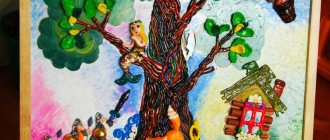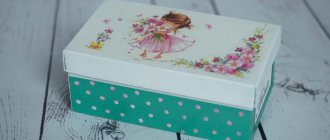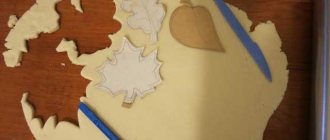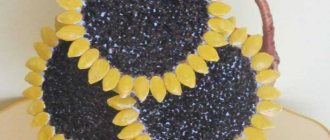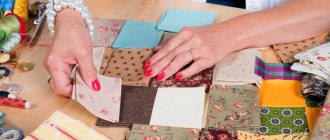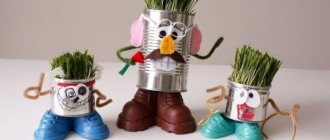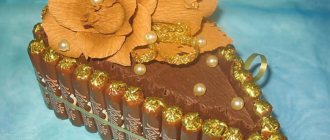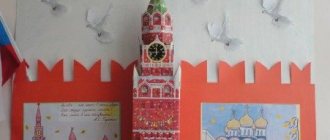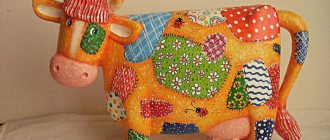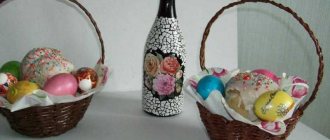To participate in the International Competition “The Second Life of Things”, photos and master classes on making crafts from waste materials , recyclable materials, household items are accepted, as well as your “life hacks” for non-standard use of various items in everyday life, which will be published on this page. Let's together come up with a new life for old things - CDs, plastic bottles, boxes, small jeans and other scrap materials! Read more about the conditions of the competitions here.
Fireplace
To create a decorative hearth, you will need a large box or several small ones, depending on the size of the future creation. Small boxes are glued together; it is better to remove the partitions that will be inside the future hearth in advance.
A “firebox” is cut in the front part of the product, into which “firewood” is subsequently placed. Firewood can be made from small real logs, their imitation from rolls of light wallpaper, branches.
To give the craft a solid or attractive look, the box is pasted over:
- Wallpaper to resemble tiles, brick or stone;
- Self-adhesive film;
- Bricks cut out of paper and everything else that its future owners would want to decorate the fireplace with.
The edges of the fireplace are finished with ceiling plinths or border strips.
Home decor is placed on the mantelpiece, and a scoop and poker are hung on a special stand. If you really want, you can also create them from cardboard.
Picnic basket
The theme of relaxation will continue with a picnic basket. You can take her to the forest, to the country house or to kindergarten. Crafts from a box of this format are made very quickly and do not require complex engineering calculations.
To create a lovely basket you will need to find:
- Shoe box;
- Quite thick twine or thin rope;
- Glue;
- A piece of fabric;
- Ribbon or thick lace.
The answer to the question “how to make a craft from a box” is very easy to solve.
- Apply a generous layer of glue to the sides of the box.
- The twine is carefully and tightly glued onto it, leaving no empty space between the turns.
- At the very top, leave a couple of centimeters unsealed, this will allow you to put the lid in place.
- The lid itself is designed in a similar way.
- The resulting baskets are glued or sewn with ribbon handles to the sides.
- A cloth napkin is placed inside the box.
Twine is sometimes replaced with fabric; in this case, the box and lid are carefully wrapped in fabric and secured with a stapler or glue. For the craft, you can use one type of fabric or decorate the lid in a contrasting color. The inside can also be decorated with fabric.
Family project “Second life of packaging”
Introduction
Relevance of the topic.
Nowadays it has become fashionable to talk about ecology and new ways of using waste. Meanwhile, every day we throw away all kinds of boxes, boxes, plastic bottles, jars (tubes) of creams and shampoo, disposable tableware, old felt-tip pens, newspapers, etc. Something has fallen into disrepair, something has lost its value, something is simply tired or unnecessary. In everyday life, a person does not think about how many unnecessary things and waste he throws into a container and takes to a landfill, where mountains and deposits of garbage accumulate. According to environmental experts, at present, for every inhabitant of the Earth, there is an average of about a ton of garbage per year. And it’s scary to think that the “cultural layer” of our time consists mainly of plastic bottles and plastic bags, which can not decompose in the ground for hundreds of years.
One of the most pressing environmental problems is the problem of pollution of the biosphere by household waste. Recently, the problem of waste recycling, among other environmental problems, has come to the fore. A huge amount of garbage accumulates on the streets of our village of Oktyabrsky, on the banks of our reservoir, in forest belts along the highway. Every person strives for cleanliness in his home. Cleans, wipes dust, washes floors, vacuums. And he does all this to ensure that the house is in order, clean and tidy. But at the same time, he often does not notice that by throwing garbage into the street, he harms himself.
To save the environment through the magic of unnecessary things, you need to find a use for them and give them a second life. If you think a little, you can not throw away old, no longer needed things, but create amazing objects out of them, giving obsolete products a second wind.
Target:
- Study materials about how people extend the life of household waste to reuse it in life, in order to protect the environment and save the raw materials of our planet. Try to give a “second life” to various packaging materials.
Tasks:
- master the elements of the research method;
- show, using examples of work, how unnecessary things can be used to preserve the environment;
- promote the development of creative abilities.
Object of study
In our project, the object of study is used packaging.
Packaging is the face of any product, its “calling card”. The main task of packaging is to preserve the quality of the product, facilitate and reduce the cost of its transportation. It is the packaging that is first assessed by the buyer, and only then the product itself. The most wonderful product, in poor packaging, will not find its buyer. Today in a grocery store it is practically impossible to find goods without packaging. The packaging carries various information useful to the buyer. This includes the manufacturer of the product, its contents, production date and shelf life. The method of use of the product and, if necessary, its dosage must be indicated.
During the study, we identified types of packaging. Kirill and I examined and examined each package.
- Glass packaging
.
Glass is one of the oldest man-made materials and has long been used to store liquids. Various glass vessels appeared in Ancient Egypt about 5 thousand years ago, and then the secret of producing glass bottles was learned in Europe. Glass products - bottles, jars, various vials - are still found by archaeologists in excavations.
- Paper and cardboard packaging.
Paper was invented in China in the 2nd century AD. And a few centuries later, the secret of its manufacture was learned in Europe. However, until the beginning of the 18th century, paper was little used for packaging, as it was made by hand and was very expensive. It was only in 1798 that a machine for its production was invented.
Paper and cardboard are made from wood pulp, which is shredded wood pulp. To do this, we have to use a lot of huge trees and cut down entire forests. But one tree suitable for processing takes, on average, 80 years to grow!
Cardboard was created in the 19th century in America; the folding cardboard box that can be seen in any store is made from this material. Only about 30 years ago people began to use a special multilayer material - cardboard covered with a thin layer of polyethylene. In boxes of such cardboard (it is called laminated) it turned out to be possible to store milk, kefir, and water. Soon another component was added - a layer of aluminum foil. In such packaging, milk can be stored without refrigeration for several months.
- Metal packaging.
Back in the early 19th century, people began to use tin to make the first tin cans, and tubes were also invented, which were a bit like tubes of toothpaste.
And in the 20th century, aluminum began to be widely used. It is now used to make tubes for paste and paints, cans for drinks and foil for confectionery.
- Plastic packaging.
The first plastic packaging appeared in the 30s of the 20th century. However, this material began to be used intensively after the Second World War.
Plastics are very diverse in their composition and properties. To make it easier to distinguish what type of plastic the packaging is made of, special markings are placed on it.
In a store, packaging plays a huge role. After all, how the seller presents this or that product to the buyer on the counter largely determines whether the buyer will like the product. And in modern supermarkets, packaging is even called a “silent seller.”
Packaging is beauty, convenience, help and protection.
Packaging protects not only the goods from damage during transportation, but also the buyer himself. Why does packaging protect us? For example, from diseases. Bacteria and germs would live very well on food if there were no packaging.
Thus, packaging is a very important and absolutely necessary thing.
Research methods
We chose the following research methods for the topic:
- collection and processing of information. (For this, the following action plan was outlined: consult with the teacher, review the literature on this topic, find the information that interests us on the Internet);
- determine which packaging materials can be used for crafts;
- together, as a family, find a useful use for these items, creating various crafts from them.
We try to keep our house clean. Another Sunday cleaning revealed a bunch of unnecessary things in the house. It’s a shame to throw it away, but there’s nowhere to put it.
In our family, like in many other families, a large number of plastic water and juice bottles, milk cartons, and candy boxes accumulate.
.
Previously, we did not think about the fact that much of this garbage could be used for new purposes, becoming the basis for original crafts. And when the teacher of the kindergarten group where our son goes offered to participate in the “Second Life of Packaging” project, we were very happy and immediately got to work.
After consulting and examining the unnecessary packaging, we came to the consensus that it is possible to breathe a second life into cardboard, paper boxes, tin cans, old plastic bags, and plastic bottles. At first, my son and I thought and fantasized about what interesting crafts we could make from all this trash. Then dad and grandma joined us.
Dad suggested making a truck out of cardboard boxes, a multi-story house, a Christmas tree out of corks, a pencil holder out of a tin can, a feeder out of a plastic bottle, and bunnies out of toilet paper cylinders. Grandmother promised to knit a napkin from old plastic bags - a stand for mugs of hot tea, make Kirill a “sultana” for morning exercises, and a box for storing needle accessories from cardboard packaging for eggs. Kirill suggested making a “wonderful box” out of the box, like in kindergarten. In the summer, Kirill and his grandmother made flower beds out of five-liter bottles. They planted garden flowers in them. They are the decoration of our garden. Everyone was busy: crafting and gluing, cutting and joining. Only grandfather watched and laughed at our idea. But when the crafts were ready, he and his grandson spent the whole evening playing with the truck.
Bird feeders.
The bird feeder was made from juice bottles. To do this, they cut a hole in it on three sides, leaving a side at the bottom. They made two holes on top with an awl and pulled a rope into them. The feeder was hung on a tree in the yard of our house.
Craft “Houses for fairy-tale characters.”
To do this, they took boxes of juice, tea, and matches. Covered with colored paper. They cut out and painted windows and doors with felt-tip pens, and decorated the walls with patterns. The roof was cut out of cardboard. And if you “build” several such houses, you will get a whole street.
Craft "Truck".
The truck was made from 2 juice boxes, bottle caps and juice straws; colored cardboard was used for decoration.
Napkin stand for a mug.
To make the napkins, we cut unnecessary cellophane bags into strips, rolled them into a ball and used them for knitting instead of threads.
Research results
If each of us in our lives does not throw away several packaging boxes, but finds a secondary use for them, then the environment will become cleaner. If you think a little, you can not throw away old, no longer needed things, but create amazing objects out of them, giving obsolete products a second wind.
After all, our whole life is surrounded by things; next to us they live their long or fleeting lives, bringing us benefit or simply delighting us. Things serve us, sometimes only for a few seconds, sometimes for an eternity. Some we carefully store, others we throw away without a second thought. The better a person lives, the more garbage there is on the planet! A huge amount of waste is generated annually (about 75 cubic meters). This waste is not always transported to specialized landfills, which leads to the formation of unauthorized landfills
If natural material, rotting, provides a fertile layer of soil, on which flowers, trees, and mushrooms then grow, then products made of plastic and polyethylene do not rot in the soil, and therefore they cannot be buried or thrown onto the ground, as they litter nature. Special factories are being built in our country, but there are still very few of them. We introduced our son to the waste disposal process at waste treatment plants.
The goal of our competition work was to study materials about how people extend the life of household waste so that they can be reused in life, how we can keep the environment clean and try to give a “second life” to various packaging materials. Kirill learned a lot of new things. By embodying our plans and ideas in various crafts, combining elements of children's play with elements of child labor, we influenced the development of our son's creative initiative.
Goal achieved
and we are glad that our whole family took part in this project!
Gift box
Any gift will bring much more joy if you put it in a neat box. And crafts from a cardboard box will also help with this.
Depending on the size of the gift, the required box is selected.
Further it can be:
- Color with paints;
- Decorate with applique;
- Decorate with bows and artificial flowers.
Or you can make an unusual candy. To do this, a hexagon is cut out of a piece of cardboard, resembling the top of a chocolate candy.
It is glued to the lid of the box, and the entire structure is painted in one color. The cute candy is ready, all that remains is to put the gift inside and hand it to the recipient.
As an unusual present, you can imitate an unnecessary cardboard container for a mailbox by placing small slats on the sides and gluing postage stamps on it.
What is secondary raw material?
Material for creativity can be something that usually goes into the trash after use:
- plastic bottles and various trays made of this material,
- bottle caps,
- carton boxes,
- disposable tableware,
- toilet paper and towel rolls,
- glass container,
- plastic canisters,
- packages,
- cans,
- car tires,
- newspapers.
All these things can get a second life in the hands of a master.
Mailbox
The original mailbox can be attached to the door of the children's room and send funny letters to the baby.
A thick candy box will be useful for this. A slot is made at the top of the box for letters. You can get the messages themselves simply by opening the lid.
Organizer
What crafts can be made from a box so that they are not only beautiful, but also useful? Maybe a stationery set or paper organizer. To do this, small boxes are decorated with paints or film. A large box is cut diagonally.
As you can see in the photo of crafts made from boxes, such sets can decorate not only a home workplace, but also office tables.
Action program
“Safe for the environment” - this is how the term eco-friendly is translated, which has become a key concept of the environmentally friendly thinking of modern people. A friendly, environmentally conscious approach is increasingly gaining popularity.
Thanks to it, we can learn to cause much less harm to our ecosystem and try to create a better standard of living. We offer you a program of practical actions to solve the problem of recycling packaging, which will help us not only become more environmentally friendly, but also save our budget.
· We try not to throw paper, plastic bottles, batteries, light bulbs and equipment into the trash. In large cities, collection points for waste paper, plastic bottles, light bulbs and batteries are appearing. All this can be handed over to Leroy-Merlin, Ikea
· Choose eco-bags. If you have already allocated a separate shelf for plastic bags, then it’s time for you to switch to eco-bags. Now you can buy them at any hypermarket and take them with you when shopping. Those who like to get creative can sew such bags themselves.
· We give clothes a second life. In Sochi, items can be donated to those in need or recycled at H&M, where you receive a discount coupon for 1 package of items brought. Nice and useful!
· We are trying to use more glassware. Between plastic containers and glass, it is more environmentally friendly to choose glass. It does not release harmful substances or odors into products, increases shelf life, and can be easily recycled. Glass jars for cereals, muesli, and nuts will protect food from food moths.
· We take food with us in lunch boxes. This is one of the most environmentally friendly and useful habits, because with this approach you do not constantly use plastic bags, do not pollute the environment, and also save a lot of money.
· We take water from home. Reusing plastic bottles or water jars is a very significant contribution to the environment. As you know, plastic does not decompose in nature for decades. Now you can buy beautiful bottles that will last you a long time.
· We buy in bulk. In “Okay”, “Magnit” or “Soap World” stores you can buy liquid soap or, for example, vegetable oil in 5-liter canisters and add them to home glass jars as needed. This is not only an environmentally friendly, but also an economical option, because when buying in bulk, you do not overpay for packaging.
Toys from boxes
A craft from a box for children in the form of a dollhouse will be useful for girls. In such a house you can comfortably accommodate all your charges, and the furniture can also be made from leftover cardboard.
- Young housewives can get their own stove, washing machine, refrigerator, and coffee machine.
- Cars, planes, and ships are more suitable for boys.
- If there are a lot of large boxes, then you can create a whole labyrinth.
- And clothespins or large crocodile clips will help to fasten them together.
Of course, such a craft is not intended for adult children, but little ones as young as one year old will certainly appreciate the funny toy. And when she gets tired of it, the sheets of cardboard are folded until better times.
conclusions
As a result of our research, we made the following conclusions:
• economic (save the family budget by creating unusual crafts with your own hands that can please family and friends);
• aesthetic (we enjoy creating various products with our own hands);
• environmental (by extending the life of packaging material , we do not pollute the environment).
I proposed practical actions to solve the problem of recycling packaging.
People don’t think about the fact that much of what we throw in the trash can get a new use, becoming the basis not only of an original craft or an exciting toy, but a full-fledged element of decor and a house for an animal. Many of these things can be given a second life , which will be no worse than the first!
cat house
A small box and an old T-shirt will help you quickly build a living structure for your furry pet. You can create a cozy resting place in just half an hour.
- To do this, a hole is cut in the box to the diameter of the neck.
- The T-shirt is stretched over the box, excess fabric is tucked into the tucks, and the bottom of the T-shirt is sewn at the back of the box.
- The sleeves of the T-shirt can be tucked inside or made into fun escape holes.
- But for this you will also have to make corresponding holes in the box.
- For hectic kittens and graceful female cats, you can create a whole cat town with ladders, labyrinths, and observation decks.
For pets
You can also make something useful out of cardboard boxes. For example, pet owners can give a second life to no longer needed packaging by making a cat house.
Cats love to relax in secluded corners; they don’t even have to do anything. However, you can make a very simple shelter by simply stretching a discarded T-shirt over a box. The neck will serve as the entrance.
For small animals such as hamsters or guinea pigs, you can make a maze. Insert cardboard walls into the base of a box (for example, a shoe box). The animal will be interested in running through the corridors of the labyrinth, and the owners will be interested in watching their pet.
Storage facilities
Shoe boxes can store more than just shoes, especially since they last somewhat longer than their contents.
From unnecessary boxes you can make a wonderful closet for storing seasonal items: hats, scarves, mittens and gloves. This will allow you to keep your main wardrobe clean and tidy and quickly find the necessary accessories.
- To create such a useful design, you simply need to label each box with bright markers or glue the appropriate labels. The boxes are placed one on top of the other with the inscriptions facing out.
A good option would be to divide the box into compartments that can accommodate pairs of socks or underwear.
Introduction
Today everyone is concerned about the environment. Humans are largely to blame. He doesn't think about what will happen to us in a few decades. Take, for example, the problem of waste. When taking trash out of an apartment, few people think about what happens to it next. The problem of recycling household waste has come to the forefront among other environmental problems in recent years.
The goal of my project is to learn through practical work how to find useful uses for household waste.
Our beloved city, the resort of Sochi, has faced this problem first-hand. We still don't have a waste recycling plant! Its construction is delayed from year to year. The most important thing is that it is planned to build not a waste processing plant, but a waste incineration plant! In European countries, garbage is no longer burned, but recycled...
Feeder
Waterproof juice and milk bags make a bird canteen.
- To do this, simply cut holes in it, thread strong twine through the top and tie it to a branch.
- Simple crafts made from boxes will not require a lot of effort and complex tools, but they can create a cozy atmosphere in the room.
